Shankar Panthi was in Dastinkali temple when the earth began to shake. As the tremors shook the foundations, he fled and joined other worshipers in a rush down to Kathmandu city some 20km in the valley below. Panthi slept rough on the bare ground until finally making contact with his family three days later.
Hearing his voice, his mother came undone with emotion.
“We are here with you Shankar,” she said through tears.
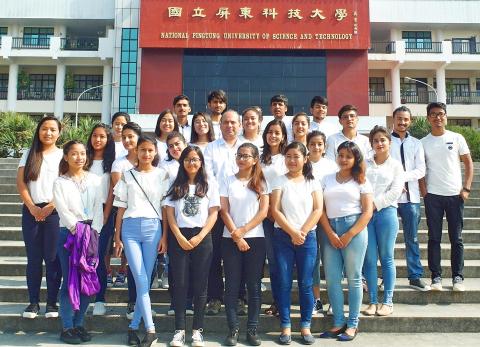
Photo courtesy of National Pingtung University of Science and Technology
The magnitude 7.8 earthquake that struck Nepal in April 2015 killed about 9,000 people, injured nearly 17,000 and left millions displaced and without food. In the wake of the tragedy, Taiwan’s International Cooperation and Development Fund (ICDF) initiated three humanitarian aid projects — two aimed at bolstering the country’s food security. The organization’s first foray into the Himalayan nation concluded last November, but it has opened new doors for Taiwan-Nepal partnership in education.
Lee Pai-po (李柏浡), ICDF Deputy Secretary-General, says that it became obvious on the ground that there was a match between the Nepali farmer’s deeper needs and the kind of agricultural expertise Taiwan is renowned for.
Three years after the earthquake, Panthi is in Taiwan learning the practical skills and expertise needed to not only see Nepal through similar disasters in the future, but develop to become an agriculturally self-sufficient country. He was joined by 25 other Nepalese who were awarded scholarships to study at National Pingtung University of Science and Technology’s Department of Tropical Agriculture, an initiative led by the Ministry of Education’s New Southbound Policy program.
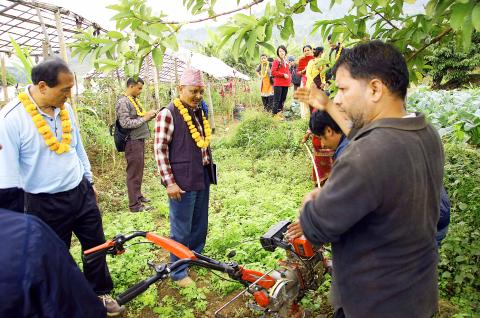
Photo courtesy of ICDF
“We need to be strong enough to support ourselves,” says Nepali program director and long-term Taiwan resident, Leknath Kafle. “For that we need to learn from Taiwan’s smart agriculture.”
CULTIVATION NATION?
The UN’s Food and Agriculture Organization (FOA) says 66 percent of Nepal’s population are engaged in farming, which, according to World Bank data, accounted for a third of its GDP in 2016. Despite this, crop failures and food shortages are chronic, meaning half of Nepali children are underweight, with malnutrition being the highest cause of death.
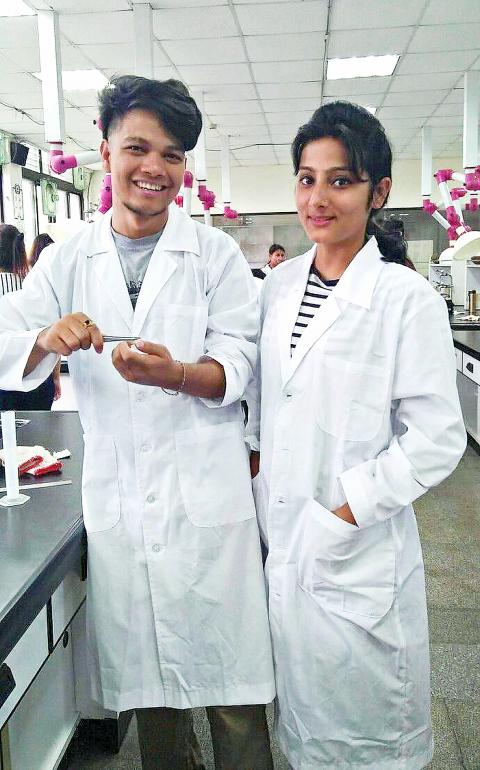
Photo courtesy of National Pingtung University of Science and Technology
Kafle says a lack of specialized research, shortage of critical irrigation infrastructure as well as obstacles to market access are the chief reasons why Nepal’s agriculture remains largely subsistence-based. He adds that knowledge gleaned from Taiwan’s research on rice cultivation, Nepal’s stable crop, is of particular benefit to his country.
Lee says the difference in harvest is noticeable — one hectare of rice paddies in Nepal yields roughly two tons of rice, as opposed to six tons in Taiwan. He adds that many Nepali farmers have used the same rice variety for decades, whereas Taiwanese farmers develop new cultivars every two to three years, which generates greater yields over the long-term.
Kafle also points to advanced research on soil orders, which has allowed Taiwan to expand the potential range of plants produced in a given area, for example growing sub-tropical fruits like oranges and pears in tropical areas. Nepal’s tropical lowlands, the terai region, makes up only 17 percent of its total territory, but is the most fertile and accessible, being relatively flat.
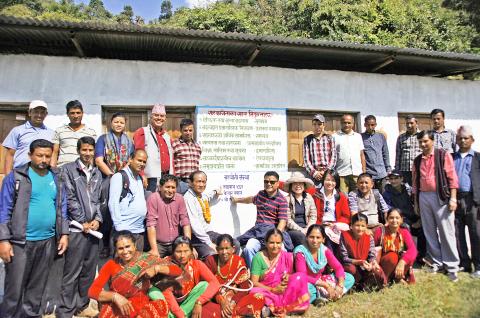
Photo courtesy of ICDF
Kafle says that if Nepal were to do the same in its fertile and accessible tropical lowlands, it would considerably raise not only the output but also diversify the range of produce available and stimulate demand for higher value cash crops.
WATER SCARCITY
Lee says Nepal’s need for critical irrigation infrastructure has become increasingly dire in recent years as global warming is causing the Himalayan ice to melt prematurely in the off season, leaving precious little fresh water for the farmers when the critical time for planting comes.
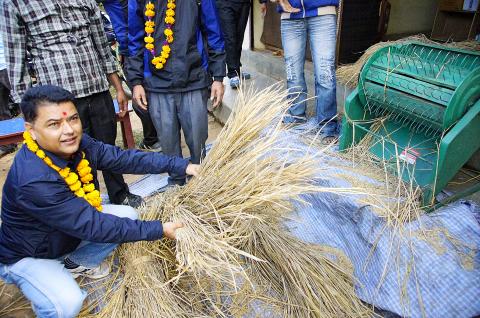
Photo courtesy of ICDF
Instead, Kale says, many farmers rely on monsoon rains, which have also become more unpredictable in recent years due to climate change.
Lee says catchment remains a critical obstacle.
“During the relief program, we instructed every village on how to build its own pond,” Lee says.
But beyond the village level, larger scale projects are needed.
Recently, Taiwan Water’s A-Team (台灣水資源 A-Team), a group of 26 of Taiwan’s best irrigation engineering enterprises, has been active in other New Southbound Policy target countries, bidding for construction projects to build new water systems in Vietnam, the Philippines, Indonesia and India.
Lee strongly recommends the group set its sights on Nepal too and Kafle offers to act as an intermediary for project coordination.
STORAGE TO STORE
Lee says selling produce to a broader market is essential to move beyond the precariousness of subsistence farming, but building storage capacity remains a stumbling block.
He says that many of the farmers he worked with had little knowledge of how to store grains, often stacking the crops on the side of the field only for them to rot after rainfall.
Lee adds that teaching the farmers how to properly store staple grains like corn and rice was one of the core outcomes of the ICDF mission in Nepal.
Kafle says without developing storage capacity, commercialization and the prospect of real development will remain out of reach for the average farmer.
Yet there may be cause for hope in the potential for Nepal’s more unique food products — if they can get them to overseas markets.
Lee says Nepal’s high-altitude organic coffee breeds are of high quality and have great market potential in Taiwan.
Kafle adds that Nepal is the main source for many herbs used to make ayurvedic medicines, for which demand is currently growing.
Lee says there is great promise for some of these rarer Himalayan herbs to be studied at Taiwan’s National Research Institute of Chinese Medicine and used to create new pharmaceutical products.
NETWORK EFFECTS
Lee says that while both have a role to play, ultimately scholarship programs are more effective than technical missions, because after the graduates return home they train local farmers faster than Taiwanese experts can, given their common language and culture.
Lee adds that these programs also bring more benefits for Taiwan as they cultivate deep-rooted networks with Nepali’s future leaders.
Lee, who founded the institute, says that, over the last twenty years, the Department of Tropical Agriculture has trained 300 to 400 international students from around the world, many of whom have gone on to become top officials in their country and even representatives at the UN Food and Agriculture Office.
He says close contact between Taiwan and these alumni has been instrumental in acting as a bridge between the two countries and shifting developmental assistance toward cooperation over the long-term.
Lee says at least two of his own former students are now planners for Nepal’s agriculture department and not only worked with ICDF on carrying out the post-earthquake programs, but are now tasked with implementing vital reforms across the sector today.
Lee likens the students to seeds of change, saying their influence will grow over the years as they rise through the ranks of Nepal’s bureaucracy.
“This is capacity building for the future,” Lee says. “With now 26 new Nepali graduates, the most we’ve ever had, there is no doubt this cohort will go on to bring transformational change to their country in years to come.”
Taiwan’s efforts to improve agricultural self-sufficiency in Nepal are part of a more general willingness to engage in humanitarian efforts abroad to improve the conditions of developing countries. Additionally, in lieu of unofficial diplomatic ties with Nepal, the importance of close links between successive generations of the countries leaders forged through the educational program cannot be underestimated.
“As I want focus on seed research, Taiwan really has everything I need,” Panthi says. “It’s my goal to take this technical knowledge back with me so Nepal can move forward.”
Bountiful South is a fortnightly column that covers Taiwan’s cultural, diplomatic, business and tourism connections with New Southbound Policy nations. Liam Gibson is a freelance reporter based in Taipei, where he researches regionalism as a postgraduate student at National Taiwan University’s Graduate Institute of National Development. You can reach him at liamtaipei@gmail.com

May 26 to June 1 When the Qing Dynasty first took control over many parts of Taiwan in 1684, it roughly continued the Kingdom of Tungning’s administrative borders (see below), setting up one prefecture and three counties. The actual area of control covered today’s Chiayi, Tainan and Kaohsiung. The administrative center was in Taiwan Prefecture, in today’s Tainan. But as Han settlement expanded and due to rebellions and other international incidents, the administrative units became more complex. By the time Taiwan became a province of the Qing in 1887, there were three prefectures, eleven counties, three subprefectures and one directly-administered prefecture, with

Taiwan Power Co (Taipower, 台電) and the New Taipei City Government in May last year agreed to allow the activation of a spent fuel storage facility for the Jinshan Nuclear Power Plant in Shihmen District (石門). The deal ended eleven years of legal wrangling. According to the Taipower announcement, the city government engaged in repeated delays, failing to approve water and soil conservation plans. Taipower said at the time that plans for another dry storage facility for the Guosheng Nuclear Power Plant in New Taipei City’s Wanli District (萬里) remained stuck in legal limbo. Later that year an agreement was reached

What does the Taiwan People’s Party (TPP) in the Huang Kuo-chang (黃國昌) era stand for? What sets it apart from their allies, the Chinese Nationalist Party (KMT)? With some shifts in tone and emphasis, the KMT’s stances have not changed significantly since the late 2000s and the era of former president Ma Ying-jeou (馬英九). The Democratic Progressive Party’s (DPP) current platform formed in the mid-2010s under the guidance of Tsai Ing-wen (蔡英文), and current President William Lai (賴清德) campaigned on continuity. Though their ideological stances may be a bit stale, they have the advantage of being broadly understood by the voters.

In a high-rise office building in Taipei’s government district, the primary agency for maintaining links to Thailand’s 108 Yunnan villages — which are home to a population of around 200,000 descendants of the Chinese Nationalist Party (KMT) armies stranded in Thailand following the Chinese Civil War — is the Overseas Community Affairs Council (OCAC). Established in China in 1926, the OCAC was born of a mandate to support Chinese education, culture and economic development in far flung Chinese diaspora communities, which, especially in southeast Asia, had underwritten the military insurgencies against the Qing Dynasty that led to the founding of